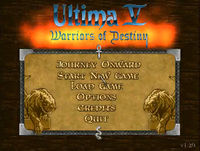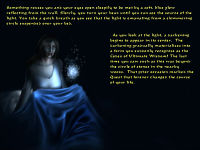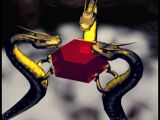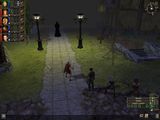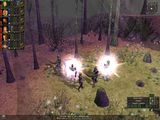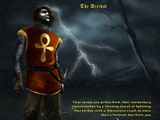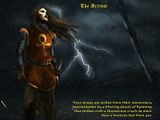Ultima V: Lazarus
This is an Ultima V: Lazarus-related article or section. The information within may not apply to Ultima V or other Ultima games.
Ultima V: Lazarus is a comprehensive remake of Ultima V: Warriors of Destiny built using Gas Powered Games' customizable Dungeon Siege engine, and released on December 22, 2005. Created and directed by Ian "Tiberius" Frazier, Lazarus was developed over the course of five years by a worldwide coordination of volunteer Ultima fans, with the goal of reimagining and expanding upon Ultima V using modern technology. As such, it contains numerous extra features, artistic upgrades, and plot embellishments not found in the original title.
Overview[edit]
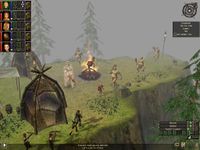
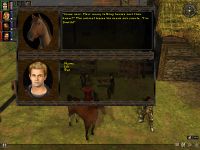
While translating as much of the content of Ultima V as feasible into the three-dimensional Dungeon Siege engine, Lazarus also expands upon its source material. In addition to new side-quests, dungeons, and hidden locations, populating the world is the entire cast of Ultima V as well as many characters created for the remake; each is depicted with a unique portrait and greatly elaborated dialogue, with a conversation system and narrative style inspired by Ultima VII.
Similarly, the underlying plot is embellished with greater nuance, building upon the original title's grim atmosphere of tyranny and legislated morality. So too is the conflict between the Resistance and the Oppression more readily apparent, and the players may opt to devote themselves to the cause of either faction, in the latter case even going to far as to conclude the game by directly aiding in victory for Lord Blackthorn and the Shadowlords.
Most of the Ultima V score appears in re-orchestrated fashion, and a wealth of new pieces were composed to further elaborate the soundtrack. A limited amount of voice acting is also present in the form of battle cries from the Avatar’s companions.
Conversely, some features found in Ultima V could not be implemented due to engine limitations and/or time constraints. These include horse riding, naval battles, usable skiffs, whirlpools, moonstone excavation, and the magic carpet.
Development[edit]
The Lazarus project was initially conceived of by Ian Frazier in 2000 as the aspiring game designer attended college, and a number of engines were under consideration for use, including Exult and Morrowind. Dungeon Siege was ultimately chosen, however, for its favorable combination of modern technology and great degree of flexibility. It was also decided early that the lauded Ultima V fan fiction, The Tale of Captain Johne, would form the basis of the Lazarus narrative, and its author, Michael "New Breed" Hilborn, soon joined the project as creative director, crafting a further background story in the form of The Fall of Lord Blackthorn.
With Dungeon Siege not seeing release until 2002, the first years of development for Lazarus focused on story design, dialogue writing, art assets, and music. The project quickly caught the attention of Gas Powered Games, and frequent communication between the two teams was established. When Dungeon Siege shipped in April 2002, Lazarus development was able to begin in earnest, with world design, gameplay mechanics, and story implementation taking the fore. Additionally at this point, a trailer consisting of 3D-rendered cinematics was released in order to maintain public enthusiasm, delivering a montage of scenes familiar to players of Ultima V.
Concurrently in development was Team Archon's The Ultima 6 Project, similarly a remake of Ultima VI built around the Dungeon Siege engine. As the magnitude of developing these ambitious projects with solely volunteer personnel became increasingly apparent, it was agreed by both teams that certain resources would be shared for the mutual benefit of each. Dubbed "Project Britannia," this initiative saw the Lazarus team contributing the world map featured in both games, while many of Team Archon's coding assets would be implemented in the Ultima V remake. Although sharing these commonalities, both projects continued to maintain independent design philosophies and creative direction.
Progress on Lazarus gained momentum thereafter, until the title finally saw a Christmas release in 2005. French and German translations of the game soon followed, as well as various bug-fixing patches, the most recent of which updated the game to version 1.2.
System requirements[edit]
The following machine specifications are the minimum required to run the PC version of Ultima V: Lazarus (the Macintosh version requires more system resources):
- 300 MHz Intel Pentium processor or equivalent i86 chip
- 128 Mb RAM (256+ recommended)
- 550 Mb free hard disk drive space
- Direct X 8.0-compatible video card
- Dungeon Siege or Dungeon Siege: Legends of Aranna
Dungeon Siege II is not compatible with Lazarus, and the original Ultima V is not required to play.
Installation instructions[edit]
For version 1.2:
- Installation of Dungeon Siege or Dungeon Siege: Legends of Aranna is first required. Dungeon Siege II will not work, as Lazarus is designed for the original Dungeon Siege engine.
- Dungeon Siege must be updated to the latest version. The 1.1 patch can be obtained from Microsoft's Dungeon Siege website. Ensure the appropriate localized patch is downloaded. If Dungeon Siege: Legends of Aranna is installed, this and the following step may be bypassed.
- Run the patch to update Dungeon Siege to version 1.1.
- At this point, it should be attempted to run Dungeon Siege to ensure it works by itself. Knowing this will help with any necessary troubleshooting later.
- If a previous version of Lazarus is already installed, it must be removed entirely from the hard drive. Any old savegames must be deleted (located in the My Documents folder under Windows) and Lazarus completely uninstalled, including the manual deletion of the install folder (C:\Lazarus, by default) before attempting to install or play 1.20.
- Install Lazarus using the installer.
- In the Start Menu, under "Programs", there will be a "Lazarus" folder. Inside there are three items of interest: the digital cloth map; the manual; and the Lazarus program launcher. The game can also be launched from the desktop icon if one is installed.
- Ensure the Dungeon Siege or Dungeon Siege: Legends of Aranna disc in the drive. This is required to play Lazarus.
- From the main menu, be sure to click options and ensure the "Video" tab is selected. Change the screen resolution to 1024x768 and click "OK." If this is not done, problems will arise during gameplay.
- From the main menu, choose "Start New Game" to begin playing.
Gallery[edit]
The Gem of Immortality as envisioned in the first Lazarus trailer
See Also[edit]
- Ultima V: Lazarus map
- In-game maps
- Ultima V: Lazarus walkthrough
- Moongate destinations
- Trainers in Ultima V: Lazarus
- Bugs
- Ultima V: Lazarus Soundtrack
- Easter Eggs in Ultima V: Lazarus
- Mini-dungeons
External links[edit]
- Ultima V: Lazarus Homepage
- Ultima V: Lazarus Fiction: The Tale of Captain Johne and The Fall of Lord Blackthorn
- Ultima V: Lazarus Game Manual (PDF)
- Ultima V: Lazarus Chronicles of Lord British's Underworld Expedition (PDF)
- Ultima V: Lazarus Cloth Map (PDF)
- Ultima V: Lazarus Music
- Ultima V: Lazarus Trailer (YouTube)
- Ultima V: Lazarus Trailer (2) (YouTube)
- Ultima V: Lazarus Forums
- Ultima V: Lazarus mod guide
- Ultima V: Lazarus – Wikipedia
- Dungeon Siege Official Site

